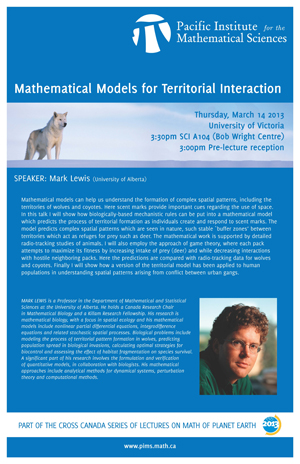Mathematical Models for Territorial Interactions: Mark Lewis
Topic
Mathematical Models for Territorial Interactions
Speakers
Details
Mathematical models can help us understand the formation of complex spatial patterns, including the territories of wolves and coyotes. Here scent marks provide important cues regarding the use of space. In this talk I will show how biologically-based mechanistic rules can be put into a mathematical model which predicts the process of territorial formation as individuals create and respond to scent marks. The model predicts complex spatial patterns which are seen in nature, such stable `buffer zones' between territories which act as refuges for prey such as deer. The mathematical work is supported by detailed radio-tracking studies of animals. I will also employ the approach of game theory, where each pack attempts to maximize its fitness by increasing intake of prey (deer) and while decreasing interactions with hostile neighboring packs. Here the predictions are compared with radio-tracking data for wolves and coyotes. Finally I will show how a version of the territorial model has been applied to human populations in understanding spatial patterns arising from conflict between urban gangs.
This is a Past Event
Event Type
Scientific, Distinguished Lecture
Date
March 14, 2013
Time
-
Location

